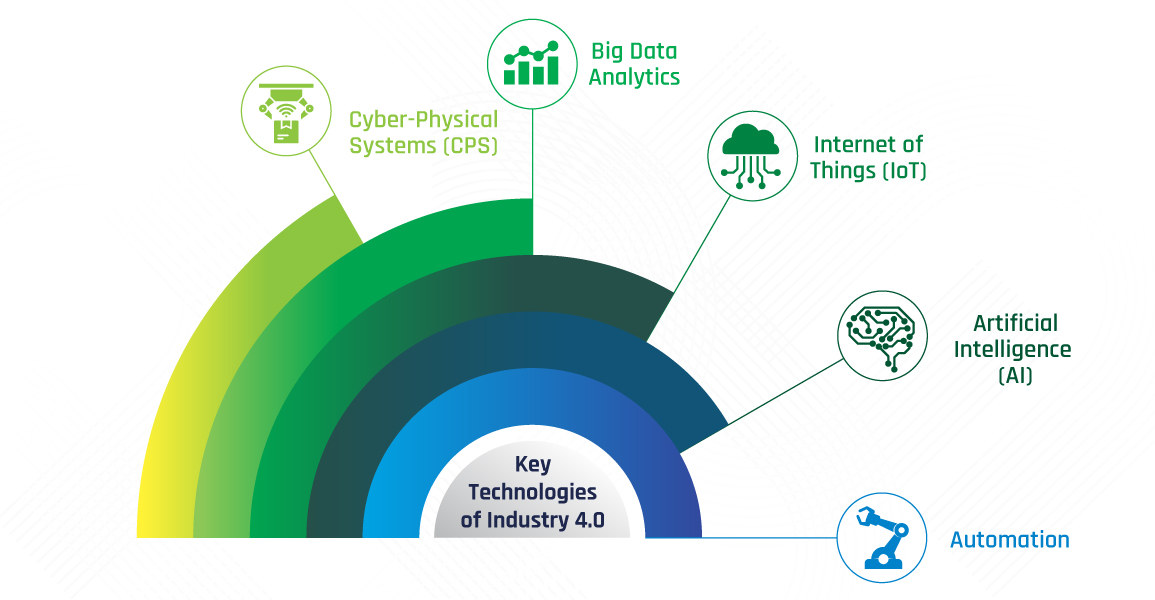
DDMRP and Risk Management: Mitigating Supply Chain Risks in Uncertain Times
June 28, 2024
The Role of Digital Twins in Simulating and Optimising DDMRP Processes
July 24, 2024In an increasingly complex and competitive global market, the efficiency of supply chains has become paramount for business success. Traditional supply chain management methods are being challenged by disruptive technologies and the dynamic nature of modern consumer demand. Enter Demand Driven Material Requirements Planning (DDMRP) and Industry 4.0. This article explores how integrating DDMRP with Industry 4.0 technologies can create a smart, responsive supply chain capable of meeting contemporary challenges.
Understanding DDMRP: A New Approach to Supply Chain Management
What is DDMRP?
Demand Driven Material Requirements Planning (DDMRP) is a modern method of supply chain management that aims to address the limitations of traditional MRP (Material Requirements Planning) systems. Traditional MRP systems often struggle with the variability and uncertainty of demand, leading to issues such as excess inventory, stockouts, and inefficiencies.
DDMRP combines elements of MRP, lean, and the theory of constraints (TOC) to create a more responsive and flexible supply chain. It focuses on positioning inventory strategically, protecting against variability, and dynamically adjusting supply to meet actual market demand.
Core Components of DDMRP
Strategic Inventory Positioning: Strategic inventory positioning entails identifying key points in the supply chain where inventory should be placed to decouple dependencies and safeguard material flow. By strategically positioning inventory, companies can create buffers that absorb variability in supply and demand, ensuring that disruptions in one part of the supply chain do not cascade through the entire system.
Buffer Profiles and Levels: Buffers are fundamental to DDMRP, and setting the right buffer profiles and levels is essential for effective supply chain management. Buffer profiles are determined based on factors such as lead times, variability, and demand patterns. Buffer levels are dynamically adjusted to maintain optimal inventory, preventing both stockouts and overstocking. These buffers are categorised into three zones: the green zone (safety stock), the yellow zone (working stock), and the red zone (replenishment trigger).
Dynamic Adjustments: Dynamic adjustments ensure that buffer levels and positions are continuously updated based on real-time data and evolving conditions. This involves regularly reviewing and adjusting buffer levels to align with actual demand and supply conditions. By dynamically adjusting buffers, companies can maintain an optimal balance between inventory and service levels, reducing excess inventory and improving responsiveness.
Demand-Driven Planning: Demand-driven planning shifts the focus from forecast-driven operations to those driven by actual demand. In this approach, replenishment and production decisions are based on real-time demand signals rather than forecasts. This enhances supply chain responsiveness, allowing companies to react quickly to changes in demand and minimise the risk of overproduction or stockouts.
Tactical Adaptation: Tactical adaptation involves managing the evolution of DDMRP through Demand Driven Sales and Operations Planning (DDS&OP). This process adjusts the model based on past performance and anticipated future activities, enhancing overall effectiveness and eliminating the need for traditional master production schedules (MPS).
Industry 4.0: The Fourth Industrial Revolution
Defining Industry 4.0
Industry 4.0, also known as the Fourth Industrial Revolution, refers to the integration of digital technologies into manufacturing and supply chain operations. It encompasses a range of technologies, including the Internet of Things (IoT), cyber-physical systems, big data analytics, artificial intelligence (AI), and automation.
Key Technologies of Industry 4.0
Cyber-Physical Systems (CPS): CPS are integrations of computation, networking, and physical processes. In the context of supply chains, CPS enables real-time monitoring and control of production processes, leading to increased efficiency and flexibility.
Big Data Analytics: The vast amount of data generated by modern supply chains can be harnessed using big data analytics. This allows companies to gain insights into patterns, trends, and anomalies, enabling better decision-making.
Internet of Things (IoT): IoT refers to the network of interconnected devices that communicate and exchange data. In supply chains, IoT devices can track inventory, monitor equipment performance, and provide real-time data on various aspects of operations.
Artificial Intelligence (AI): AI technologies, such as machine learning and predictive analytics, can optimise supply chain processes by predicting demand, identifying inefficiencies, and automating decision-making.
Automation: Automation technologies, including robotics and autonomous vehicles, can streamline various supply chain activities, from manufacturing to warehousing and distribution.

Integrating DDMRP and Industry 4.0: A Synergistic Approach
The Benefits of Integration
Integrating DDMRP with Industry 4.0 technologies offers several advantages:
Enhanced Visibility: IoT devices and CPS provide real-time data on inventory levels, production status, and demand patterns. This visibility enables more accurate and timely adjustments to buffer levels in DDMRP.
Improved Demand Sensing: Big data analytics and AI can enhance demand sensing capabilities by analysing historical data, market trends, and external factors. This leads to more accurate demand forecasts and better buffer management.
Increased Agility: Automation and AI enable faster and more efficient execution of supply chain activities. Automated replenishment and production adjustments can respond rapidly to changes in demand, ensuring that the right products are available at the right time.
Reduced Lead Times: Strategic positioning of inventory, combined with real-time monitoring and control through CPS, reduces lead times and improves overall supply chain responsiveness.
Cost Optimization: By dynamically adjusting inventory levels and optimising production schedules, companies can reduce excess inventory and minimise costs associated with stockouts and overproduction.
Practical Implementation Strategies
IoT-Enabled Inventory Management
Integrating IoT devices into inventory management systems allows for real-time tracking of stock levels, locations, and conditions. Sensors can monitor factors such as temperature and humidity, ensuring that products are stored under optimal conditions. This data feeds into the DDMRP system, enabling dynamic adjustments to buffer levels based on actual consumption and environmental conditions.
AI-Driven Demand Forecasting
AI and machine learning algorithms can analyse vast amounts of historical data and external factors to predict demand more accurately. These predictions can be integrated with DDMRP to adjust buffer profiles and levels proactively. For instance, an AI system might identify a trend indicating an upcoming spike in demand for a particular product, prompting the DDMRP system to increase buffer levels accordingly.
Automated Replenishment and Production
Automation technologies, such as robotics and autonomous vehicles, can streamline replenishment and production processes. For example, automated guided vehicles (AGVs) can transport materials and products within a warehouse, ensuring that inventory is moved efficiently. Automated production lines can adjust output based on real-time demand signals, reducing lead times and minimising the risk of overproduction.

Big Data Analytics for Continuous Improvement
Big data analytics can provide insights into supply chain performance, identifying areas for improvement and optimization. By analysing data from IoT devices, production systems, and market trends, companies can continuously refine their DDMRP strategies. For instance, analytics might reveal that certain buffer profiles are consistently underperforming, prompting adjustments to improve responsiveness and reduce costs.
Cyber-Physical Systems for Real-Time Control
Cyber-physical systems enable real-time monitoring and control of production processes. These systems can detect deviations from planned production schedules and adjust operations accordingly. For example, if a machine breakdown occurs, the CPS can reroute production tasks to other machines, minimising downtime and ensuring that supply chain operations continue smoothly.
Case Studies: Real-World Applications of DDMRP and Industry 4.0
Case Study 1: Siemens’ Digital Factory
Siemens, a global leader in industrial automation and digitalization, has implemented DDMRP in its digital factory in Amberg, Germany. The factory utilises IoT devices, CPS, and big data analytics to create a highly responsive and efficient supply chain.
By integrating DDMRP with these Industry 4.0 technologies, Siemens has achieved significant improvements in lead times, inventory levels, and overall supply chain performance. The real-time visibility provided by IoT devices and CPS allows for dynamic adjustments to buffer levels, ensuring that production processes are aligned with actual demand.
Source: https://www.hbs.edu/faculty/Pages/item.aspx?num=52376
Case Study 2: Procter & Gamble’s Smart Supply Chain
Procter & Gamble (P&G), a multinational consumer goods company, has integrated DDMRP with Industry 4.0 technologies to enhance its supply chain responsiveness. P&G utilises AI-driven demand forecasting, IoT-enabled inventory management, and automated production systems to create a smart, agile supply chain.
By leveraging these technologies, P&G has reduced lead times, improved demand accuracy, and minimised inventory holding costs. The integration of DDMRP with Industry 4.0 has enabled P&G to respond quickly to changes in consumer demand, ensuring that products are available when and where they are needed.
Source: https://www.slideshare.net/slideshow/pg-supply-chain-management/9649873
Case Study 3: BMW’s Autonomous Supply Chain
BMW, a leading automotive manufacturer, has embraced Industry 4.0 technologies to create an autonomous supply chain. The company utilises AGVs, robotics, and AI-driven systems to streamline its production and logistics processes.
By integrating DDMRP with these technologies, BMW has achieved greater flexibility and responsiveness in its supply chain. Automated systems adjust production schedules and inventory levels based on real-time demand signals, reducing lead times and optimising resource utilisation.
Source: https://www.bmwgroup.com/en/news/general/2019/open-manufacturing-platform.html
Challenges and Considerations in Integrating DDMRP and Industry 4.0
Technological Integration
Integrating DDMRP with Industry 4.0 technologies requires a robust IT infrastructure capable of handling large volumes of data and supporting real-time decision-making. Companies must invest in IoT devices, CPS, AI systems, and automation technologies, as well as the necessary software and hardware to integrate these components.
Data Management and Security
The integration of Industry 4.0 technologies generates vast amounts of data, which must be managed effectively. Companies need to implement data management strategies to ensure data quality, accuracy, and accessibility. Additionally, cybersecurity measures are essential to protect sensitive supply chain data from cyber threats.

Change Management
Implementing DDMRP and Industry 4.0 technologies requires significant changes to existing supply chain processes and organisational structures. Companies must invest in training and development programs to equip employees with the skills needed to operate and manage these technologies. Change management strategies should also address potential resistance to new processes and technologies.
Cost Considerations
While the benefits of integrating DDMRP with Industry 4.0 are substantial, the initial investment can be significant. Companies must carefully evaluate the costs and benefits of implementing these technologies, considering factors such as return on investment (ROI), total cost of ownership (TCO), and long-term sustainability.
Future Trends and Opportunities
Enhanced Collaboration and Connectivity
The future of supply chain management lies in enhanced collaboration and connectivity. Industry 4.0 technologies enable seamless communication and data exchange between different stakeholders, including suppliers, manufacturers, and customers. This connectivity facilitates greater collaboration, leading to more efficient and responsive supply chain operations.
Advanced Analytics and AI
The continued development of advanced analytics and AI technologies will further enhance supply chain management capabilities. Predictive analytics, machine learning, and AI-driven decision-making will enable companies to anticipate and respond to market changes more effectively. These technologies will also facilitate the continuous improvement of DDMRP strategies, ensuring optimal performance and responsiveness.
Sustainable Supply Chains
Sustainability is becoming an increasingly important consideration in supply chain management. Industry 4.0 technologies can support sustainable practices by optimising resource utilisation, reducing waste, and minimising environmental impact. Companies that integrate DDMRP with sustainable practices will be better positioned to meet regulatory requirements and consumer expectations.
Blockchain for Transparency and Traceability
Blockchain technology offers potential benefits for supply chain transparency and traceability. By providing a secure, immutable record of transactions and movements, blockchain can enhance trust and accountability across the supply chain. Integrating blockchain with DDMRP and Industry 4.0 technologies can improve visibility and traceability, ensuring that products meet quality and safety standards.
Conclusion
Integrating DDMRP with Industry 4.0 technologies represents a significant opportunity for companies to create smart, responsive, and agile supply chains. By leveraging IoT, big data analytics, AI, and automation, companies can enhance visibility, improve demand sensing, increase agility, reduce lead times, and optimise costs. However, successful integration requires careful planning, investment in technology and infrastructure, and effective change management strategies.
As the Fourth Industrial Revolution continues to unfold, the convergence of DDMRP and Industry 4.0 will play a crucial role in shaping the future of supply chain management. Companies that embrace this integration will be better equipped to navigate the complexities of modern markets, respond to dynamic consumer demand, and achieve sustained competitive advantage.
Explore how integrating DDMRP with Industry 4.0 can enhance your operational efficiency and responsiveness. Get in touch today!





